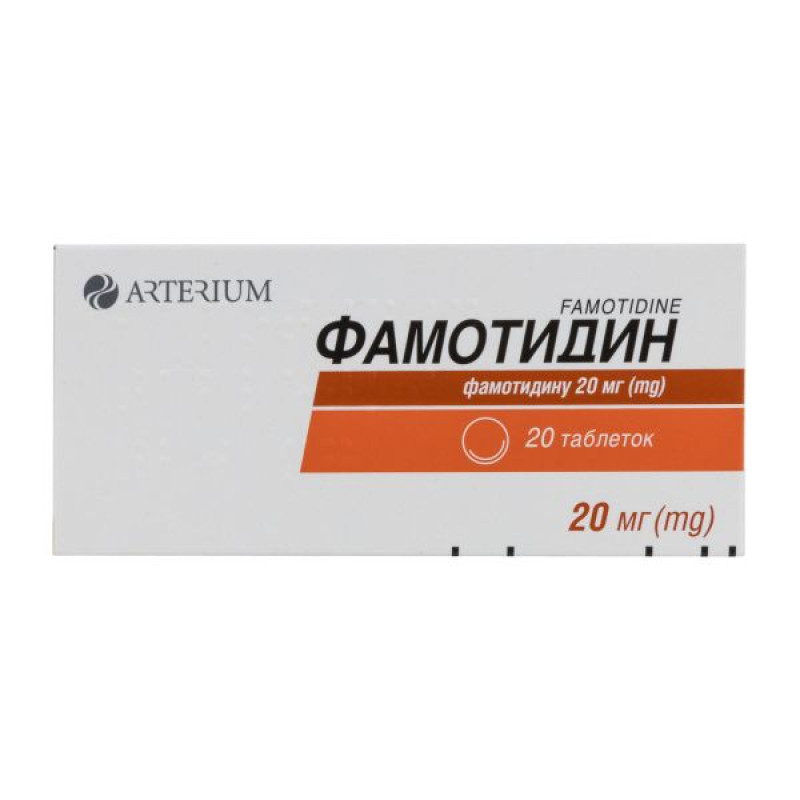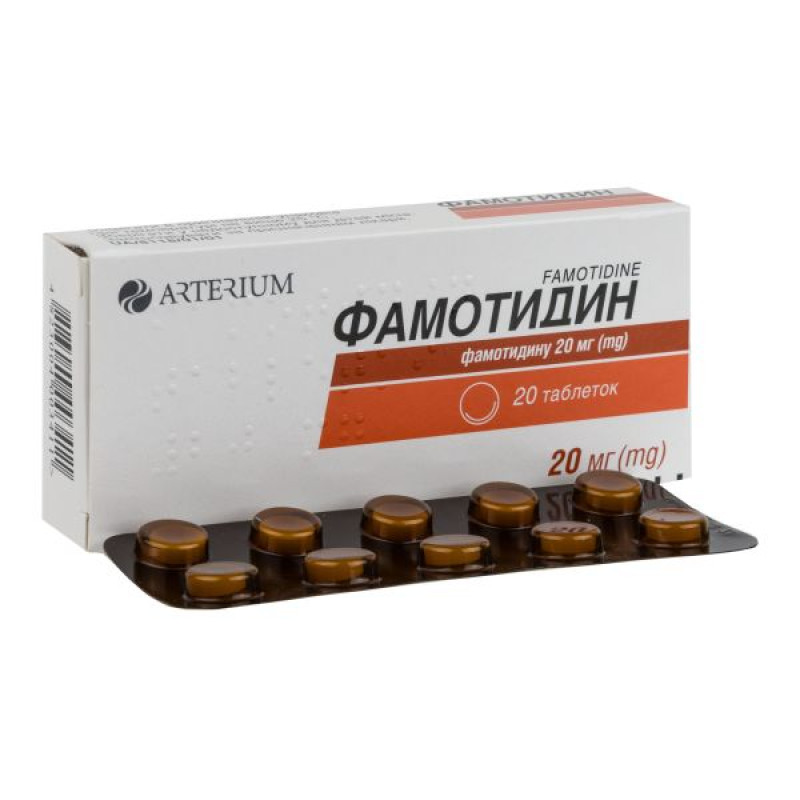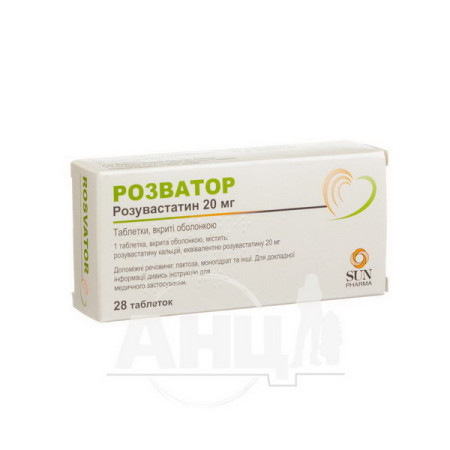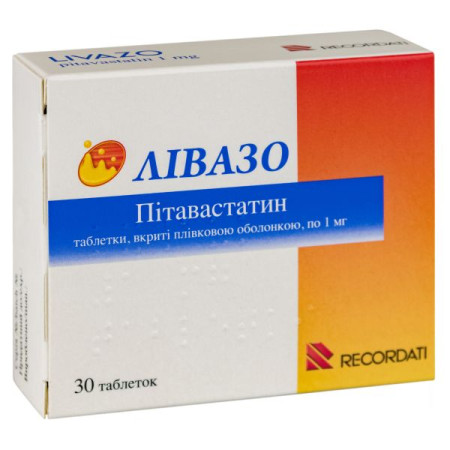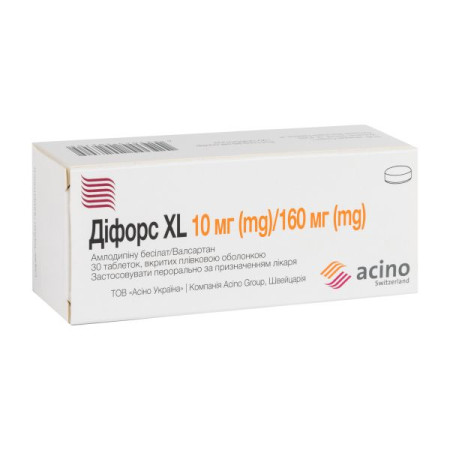Famotidine tablets 20 mg blister No. 20
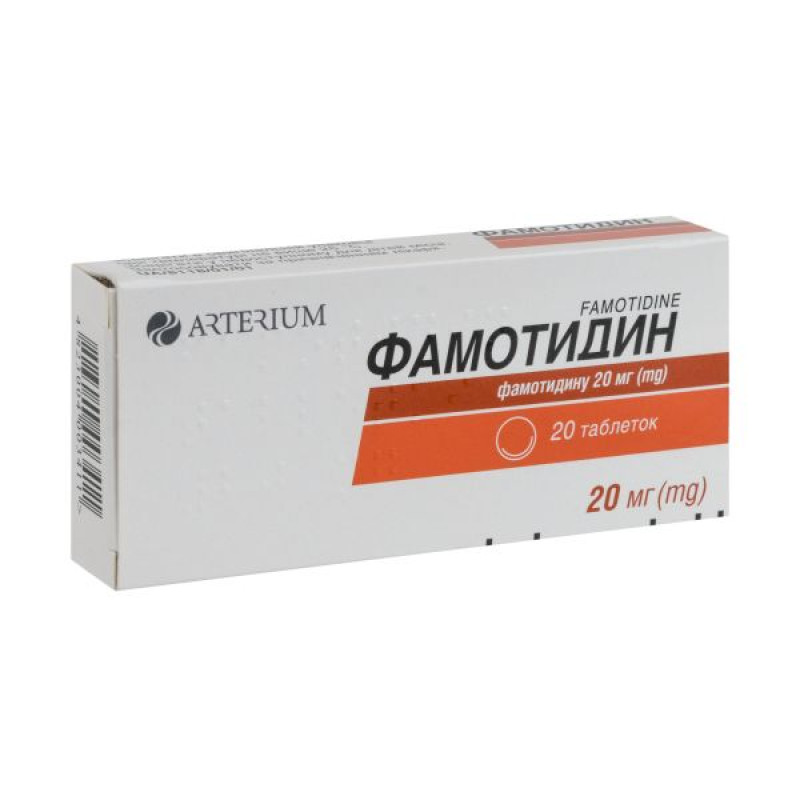
Instructions Famotidine tablets 20 mg blister No. 20
Composition
active ingredient: famotidine;
1 tablet contains famotidine in terms of 100% substance 20 mg;
Excipients: lactose monohydrate; potato starch; povidone; calcium stearate; colloidal anhydrous silicon dioxide.
Dosage form
Pills.
Main physicochemical properties: tablets of white or white with a creamy tint, round in shape, with a flat surface, with a bevel.
Pharmacotherapeutic group
Drugs for the treatment of peptic ulcer and gastroesophageal reflux disease. H2-receptor antagonists. ATC code A02B A03.
Pharmacological properties
Pharmacodynamics
Famotidine is a potent competitive inhibitor of H2-histamine receptors. The main clinically significant pharmacological action of famotidine is inhibition of gastric secretion. Famotidine reduces both the concentration of acid and the volume of gastric secretion, while pepsin production remains proportional to the volume of gastric juice secreted.
Famotidine inhibits basal and nocturnal gastric secretion, as well as secretion stimulated by the administration of pentagastrin, betazol, caffeine, insulin, and the physiological vagus nerve reflex.
The duration of secretion inhibition when using doses of 20 mg and 40 mg is from 10 to 12 hours.
Single oral doses of 20 mg and 40 mg in the evening provide suppression of basal and nocturnal acid secretion.
Nocturnal acid secretion is suppressed by 86–94% for at least 10 hours. The same doses taken in the morning reduce acid secretion stimulated by food. This suppression is 76–84% of the initial secretion 3–5 hours after administration and 25% and 30% at 8 and 10 hours after ingestion.
Famotidine has little effect on fasting or postprandial gastrin levels. It has no effect on gastric emptying, pancreatic exocrine function, hepatic blood flow, or portal blood flow.
Pharmacokinetics
The kinetics of famotidine are linear.
Absorption. Famotidine is rapidly absorbed. The oral bioavailability is 40–45%. Bioavailability does not change depending on the contents of the stomach, but is slightly reduced when taking antacids.
In elderly patients, no clinically significant age-related changes in the bioavailability of famotidine were found.
First-pass biotransformation through the liver has little effect on the bioavailability of the drug.
Distribution. After oral administration, the maximum concentration of the drug in the blood plasma is reached after 1–3 hours. With repeated administration, there is no cumulative effect. Binding to plasma proteins is relatively low, 15–20%.
The half-life is 2.3–3.5 hours. In patients with severe renal insufficiency, the half-life of famotidine may exceed 20 hours.
The drug is metabolized in the liver. The only metabolite identified in humans is the sulfoxide.
Famotidine is excreted renally (65–70%) and by metabolism (30–35%). Renal clearance is 250–450 mL/min, indicating some degree of tubular excretion. 25–30% of an oral dose and 65–70% of an intravenous dose are recovered in the urine as unchanged drug. A small portion of the administered dose may be excreted as the sulfoxide.
Indication
Benign gastric ulcer. Peptic ulcer of the duodenum (treatment and prevention of relapse). Hypersecretory conditions such as Zollinger-Ellison syndrome. Treatment of gastroesophageal reflux disease (reflux oesophagitis). Prevention of the development of symptoms and erosions or ulceration associated with gastroesophageal reflux disease.
Contraindication
Hypersensitivity to any component of the drug and to other H2-histamine receptor antagonists. Children's age, pregnancy or breastfeeding (due to lack of necessary clinical experience).
Interaction with other medicinal products and other types of interactions
The absorption of certain drugs (e.g. ketoconazole, amoxicillin, iron preparations) depends on gastric acidity. Therefore, famotidine should be taken at least 2 hours after taking such drugs.
Concomitant use with other H2-receptor antagonists may significantly reduce the effectiveness of tolazoline. Although there are no confirmed interactions between famotidine and tolazoline, the likelihood of their existence is quite high, so the effect of tolazoline should be checked at the beginning and after the end of concomitant treatment. In case of a decrease in the effect of tolazoline, its dose should be gradually increased or treatment with famotidine should be discontinued.
Food and antacids have no significant effect on famotidine treatment.
Famotidine does not affect the hepatic cytochrome P450 oxidase system, so the metabolism of oral anticoagulants, antipyrine, aminopyrine, theophylline, phenytoin, diazepam, ethanol, and propranolol remains unchanged.
Probenecid may slow the release of famotidine.
Application features
Before starting treatment with famotidine, it is necessary to exclude the presence of malignant neoplasms in the stomach and duodenum. Treatment with this drug may mask the symptoms of gastric carcinoma.
In case of liver failure, Famotidine should be used with caution and in low doses.
Since cross-sensitivity between H2-receptor antagonists has been reported, the use of Famotidine in patients with hypersensitivity to other H2-receptor antagonists is contraindicated.
Treatment with Famotidine cannot be carried out without a doctor's prescription or without a proper medical examination if:
the patient suffers from kidney or liver disease (elderly patients or patients with impaired liver or kidney function may experience mental disorders (confusion), requiring a dose reduction); the patient suffers from concomitant diseases or is taking other medications at the same time; a middle-aged or elderly patient has complaints of digestive disorders for the first time or previous complaints have changed; the patient has complaints of stomach function, the patient has lost weight; the patient's stools are black; the patient has swallowing disorders or chronic abdominal pain.
The drug should be used with caution in case of acute porphyria (including a history) and immunodeficiency.
Symptoms of duodenal ulcer may resolve within 1–2 weeks, but treatment should be continued until scarring is confirmed by endoscopic or X-ray examination.
Regular monitoring of the condition of patients (especially elderly patients and patients with a history of gastric and/or duodenal ulcer) who use the drug in combination with nonsteroidal anti-inflammatory drugs is necessary.
In the case of complex treatment with antacids, the interval between the use of the drug and antacids should be at least 1–2 hours.
If a dose is missed, it should be taken as soon as possible; do not double the dose if it is time for the next dose.
Treatment with the drug should not be started without prior appropriate medical examination in the presence of heartburn, manifestations of hyperacidity, stomach pain, or hyperacidity after meals in elderly patients.
Patients should be warned that 1 tablet of Famotidine 20 mg contains lactose, therefore patients with galactose intolerance, Lapp lactase deficiency or glucose-galactose malabsorption should not use this drug.
Ability to influence reaction speed when driving vehicles or other mechanisms
Patients should be careful when performing potentially hazardous activities that require increased attention and speed of psychomotor reactions, as the drug may cause dizziness.
Use during pregnancy or breastfeeding
Pregnancy: Famotidine crosses the placenta. There are no adequate and well-controlled studies in pregnant women.
Famotidine is not recommended for use during pregnancy.
Breastfeeding. Famotidine passes into human breast milk, so breastfeeding should be discontinued during use of the drug.
Method of administration and doses
The drug is most effective in the evening before bedtime. When taking famotidine 2 times a day, one dose should be taken in the morning and the other in the evening before bedtime.
Peptic ulcer of the duodenum and stomach (benign)
40 mg in the evening before bedtime for 4–8 weeks.
Prevention of duodenal ulcer recurrence
In order to prevent relapses after achieving a therapeutic effect, the drug should be prescribed in a maintenance dose: 20 mg once at night for 1–4 weeks.
Gastroesophageal reflux disease (reflux esophagitis)
20 mg or 40 mg (depending on the severity of the disease) 2 times a day for 6–12 weeks.
For gastroesophageal reflux disease associated with erosive esophagitis or ulcer – 40 mg 2 times a day for 6–12 weeks.
For the prevention of recurrence of symptoms and erosions or ulceration associated with gastroesophageal reflux disease (maintenance therapy).
Prescribe 20 mg 2 times a day.
Zollinger-Ellison syndrome
The dose of the drug should be selected individually. Patients who have not previously been prescribed antisecretory drugs should be prescribed an initial dose of 20 mg 4 times a day (every 6 hours). Patients who have previously used other histamine H2-receptor antagonists may be immediately prescribed a higher initial dose of 40 mg every 6 hours. In the future, the dose should be adjusted depending on the level of gastric juice secretion, as well as the clinical condition of the patient. Treatment should be carried out as long as clinical symptoms of the disease are observed.
If necessary, the daily dose is increased gradually depending on individual characteristics until the optimal dose is reached.
According to literature data, the highest doses of famotidine taken by patients with severe forms of the disease were up to 160 mg every 6 hours.
Dosage in renal failure
Treatment with the drug should be discontinued gradually due to the risk of rebound syndrome with sudden withdrawal.
Dosage for the elderly
No dose adjustment is necessary for the elderly, except in patients with renal insufficiency.
Children
This drug should not be prescribed to children due to the lack of experience with its use in this category of patients.
Overdose
Symptoms: vomiting, motor agitation, tremor, decreased blood pressure, tachycardia, and collapse may develop.
Treatment: discontinuation of the drug, induction of vomiting and/or gastric lavage.
If necessary, appropriate symptomatic and supportive treatment can be used: intravenous diazepam for convulsions, atropine for bradycardia, and lidocaine for ventricular arrhythmia. Effective hemodialysis.
Adverse reactions
The following adverse events are listed by system organ class. However, a causal relationship to famotidine therapy has not been established.
| Organ system | Adverse reactions |
| Deviations from the norm of laboratory parameters | Elevated liver enzymes |
| From the heart | Atrioventricular block, arrhythmia, decreased blood pressure, bradycardia, tachycardia |
| From the circulatory and lymphatic system | Thrombocytopenia, agranulocytosis, pancytopenia, leukopenia, neutropenia |
| From the nervous system | Headache, dizziness, convulsions, paresthesia, balance disorders |
| From the organs of vision | Conjunctivitis |
| From the hearing organs | Tingle |
| Respiratory, thoracic and mediastinal disorders | Airway obstruction |
| Gastrointestinal tract | Diarrhea, constipation, flatulence, stomach pain, vomiting, nausea, dysgeusia, dry mouth, acute pancreatitis |
| Skin and subcutaneous tissue disorders | Severe skin reactions (Stevens-Johnson syndrome, exfoliative dermatitis, toxic epidermal necrolysis), acne, urticaria, skin rash, hair loss, pruritus, erythema, xeroderma |
| Musculoskeletal and connective tissue disorders | Myalgia, bone pain, or arthralgia |
| Metabolic and nutritional disorders | Anorexia |
| Systemic disorders | Fatigue, fever |
| On the part of the immune system | Hypersensitivity reactions, including anaphylaxis, angioedema, urticaria, eye swelling |
| Hepatobiliary system | Cholestatic jaundice, hepatitis |
| From the psyche | Agitation, hallucinations, confusion, depression, fear, insomnia, drowsiness, decreased libido |
| Genital and mammary glands | Impotence, gynecomastia* |
* Gynecomastia is very rare and reversible upon discontinuation of treatment.
If any serious adverse reactions develop, treatment with Famotidine should be discontinued.
Expiration date
4 years.
Storage conditions
Store in original packaging at a temperature not exceeding 25 ° C. Keep out of the reach of children.
Packaging
10 tablets in a blister, 2 blisters in a pack.
Vacation category
According to the recipe.
Producer
PJSC "Kyivmedpreparat".
Location of the manufacturer and its business address
Ukraine, 01032, Kyiv, Saksaganskoho St., 139.
There are no reviews for this product.
There are no reviews for this product, be the first to leave your review.
No questions about this product, be the first and ask your question.







